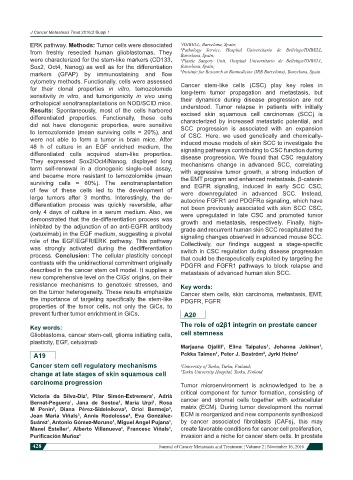Page 438 - Read Online
P. 438
J Cancer Metastasis Treat 2016;2 Suppl 1
ERK pathway. Methods: Tumor cells were dissociated 1 IDIBELL, Barcelona, Spain;
Pathology Service, Hospital Universitario de Bellvitge/IDIBELL,
from freshly resected human glioblastomas. They 2 Barcelona, Spain;
were characterized for the stem-like markers (CD133, 3 Plastic Surgery Unit, Hospital Universitario de Bellvitge/IDIBELL,
Sox2, Oct4, Nanog) as well as for the differentiation Barcelona, Spain;
markers (GFAP) by immunostaining and flow 4 Institute for Research in Biomedicine (IRB Barcelona), Barcelona, Spain
cytometry methods. Functionally, cells were assessed Cancer stem-like cells (CSC) play key roles in
for their clonal properties in vitro, temozolomide long-term tumor propagation and metastasis, but
sensitivity in vitro, and tumorigenicity in vivo using their dynamics during disease progression are not
orthotopical xenotransplantations on NOD/SCID mice. understood. Tumor relapse in patients with initially
Results: Spontaneously, most of the cells harbored excised skin squamous cell carcinomas (SCC) is
differentiated properties. Functionally, these cells characterized by increased metastatic potential, and
did not have clonogenic properties, were sensitive SCC progression is associated with an expansion
to temozolomide (mean surviving cells = 20%), and of CSC. Here, we used genetically and chemically-
were not able to form a tumor in brain mice. After induced mouse models of skin SCC to investigate the
48 h of culture in an EGF enriched medium, the signaling pathways contributing to CSC function during
differentiated cells acquired stem-like properties. disease progression. We found that CSC regulatory
They expressed Sox2/Oct4/Nanog, displayed long mechanisms change in advanced SCC, correlating
term self-renewal in a clonogenic single-cell assay, with aggressive tumor growth, a strong induction of
and became more resistant to temozolomide (mean the EMT program and enhanced metastasis. β-catenin
surviving cells = 60%). The xenotransplantation and EGFR signaling, induced in early SCC CSC,
of few of these cells led to the development of were downregulated in advanced SCC. Instead,
large tumors after 3 months. Interestingly, the de- autocrine FGFR1 and PDGFRα signaling, which have
differentiation process was quickly reversible, after not been previously associated with skin SCC CSC,
only 4 days of culture in a serum medium. Also, we were upregulated in late CSC and promoted tumor
demonstrated that the de-differentiation process was growth and metastasis, respectively. Finally, high-
inhibited by the adjunction of an anti-EGFR antibody grade and recurrent human skin SCC recapitulated the
(cetuximab) in the EGF medium, suggesting a pivotal signaling changes observed in advanced mouse SCC.
role of the EGF/EGFR/ERK pathway. This pathway Collectively, our findings suggest a stage-specific
was strongly activated during the dedifferentiation switch in CSC regulation during disease progression
process. Conclusion: The cellular plasticity concept that could be therapeutically exploited by targeting the
contrasts with the unidirectional commitment originally PDGFR and FGFR1 pathways to block relapse and
described in the cancer stem cell model. It supplies a metastasis of advanced human skin SCC.
new comprehensive level on the CiGs’ origins, on their
resistance mechanisms to genotoxic stresses, and Key words:
on the tumor heterogeneity. These results emphasize Cancer stem cells, skin carcinoma, metastasis, EMT,
the importance of targeting specifically the stem-like PDGFR, FGFR
properties of the tumor cells, not only the GiCs, to
prevent further tumor enrichment in GiCs. A20
The role of α2β1 integrin on prostate cancer
Key words:
Glioblastoma, cancer stem-cell, glioma initiating cells, cell stemness
plasticity, EGF, cetuximab
Marjaana Ojalill , Elina Taipalus , Johanna Jokinen ,
1
1
1
1
2
A19 Pekka Taimen , Peter J. Boström , Jyrki Heino 1
Cancer stem cell regulatory mechanisms 1 University of Turku, Turku, Finland;
change at late stages of skin squamous cell 2 Turku University Hospital, Turku, Finland
carcinoma progression Tumor microenvironment is acknowledged to be a
critical component for tumor formation, consisting of
1
1
Victoria da Silva-Diz , Pilar Simón-Extremera , Adrià
1
1
1
Bernat-Peguera , Jana de Sostoa , Maria Urpi , Rosa cancer and stromal cells together with extracellular
M Penín , Diana Pérez-Sidelnikova , Oriol Bermejo , matrix (ECM). During tumor development the normal
3
3
2
3
Joan Maria Viñals , Annie Rodolosse , Eva González- ECM is reorganized and new components synthesized
4
1
Suárez , Antonio Gómez-Moruno , Miguel Angel Pujana , by cancer associated fibroblasts (CAFs), this may
1
1
Manel Esteller , Alberto Villanueva , Francesc Viñals , create favorable conditions for cancer cell proliferation,
1
1
1
Purificación Muñoz 1 invasion and a niche for cancer stem cells. In prostate
428
Journal of Cancer Metastasis and Treatment ¦ Volume 2 ¦ November 16, 2016

